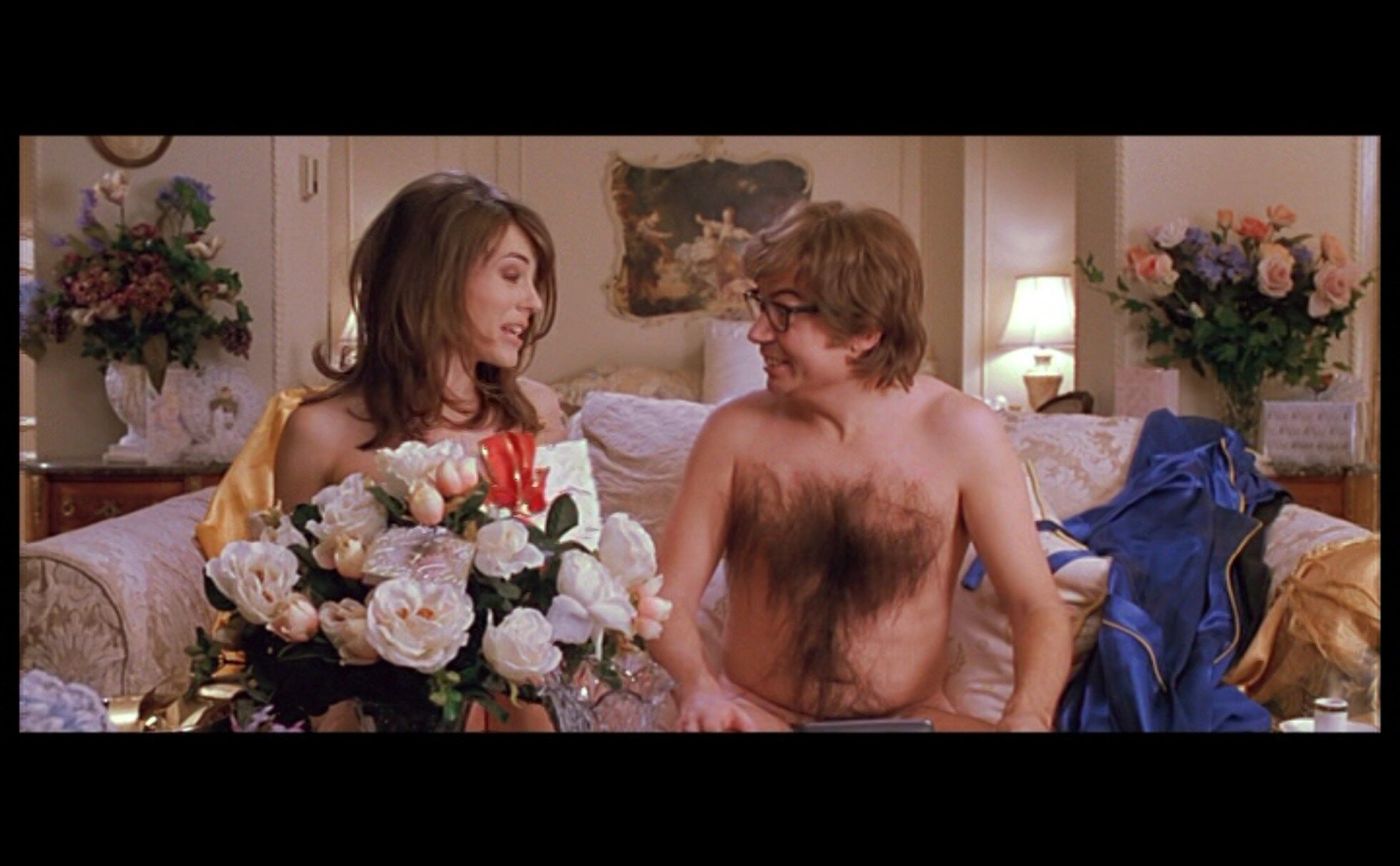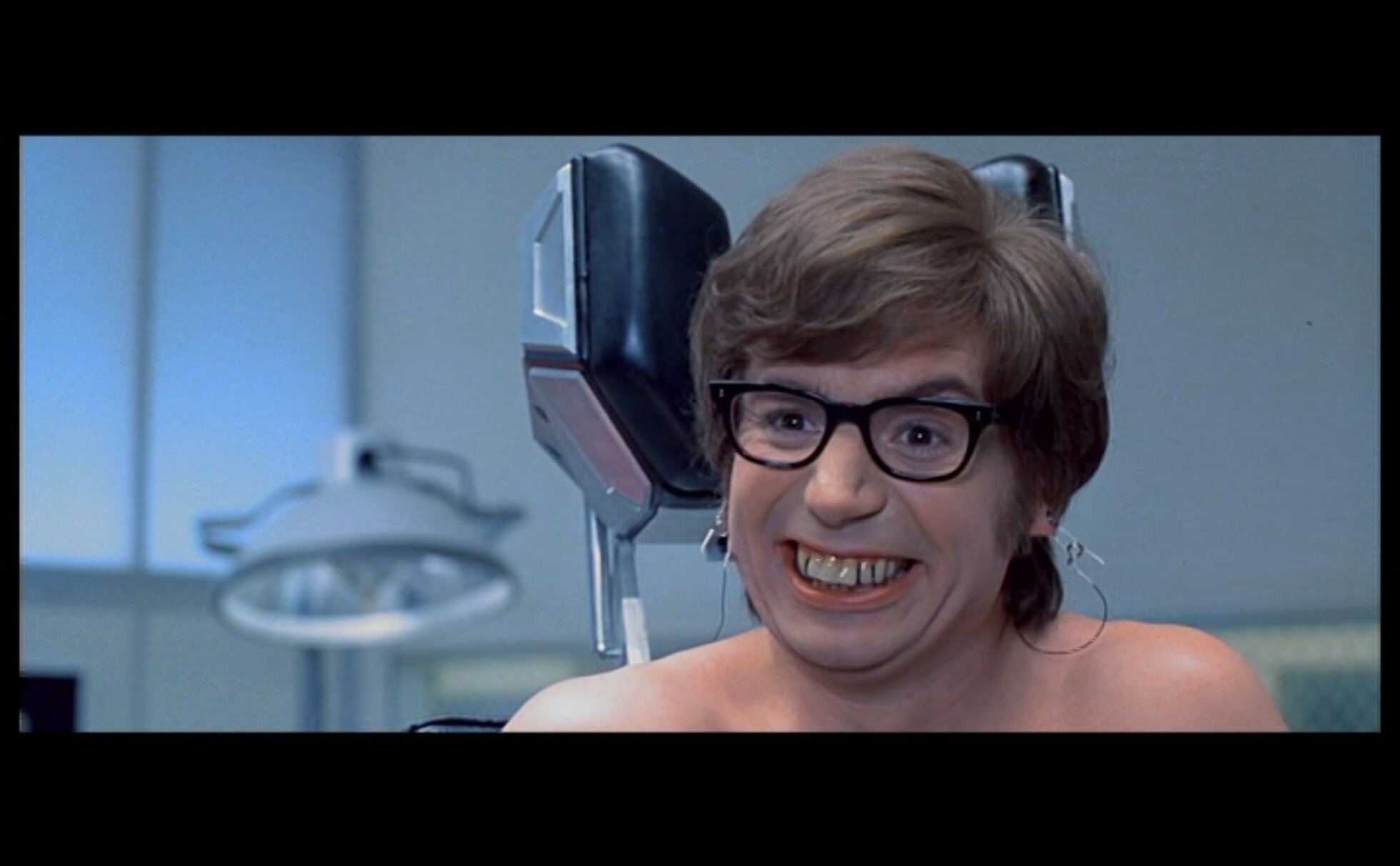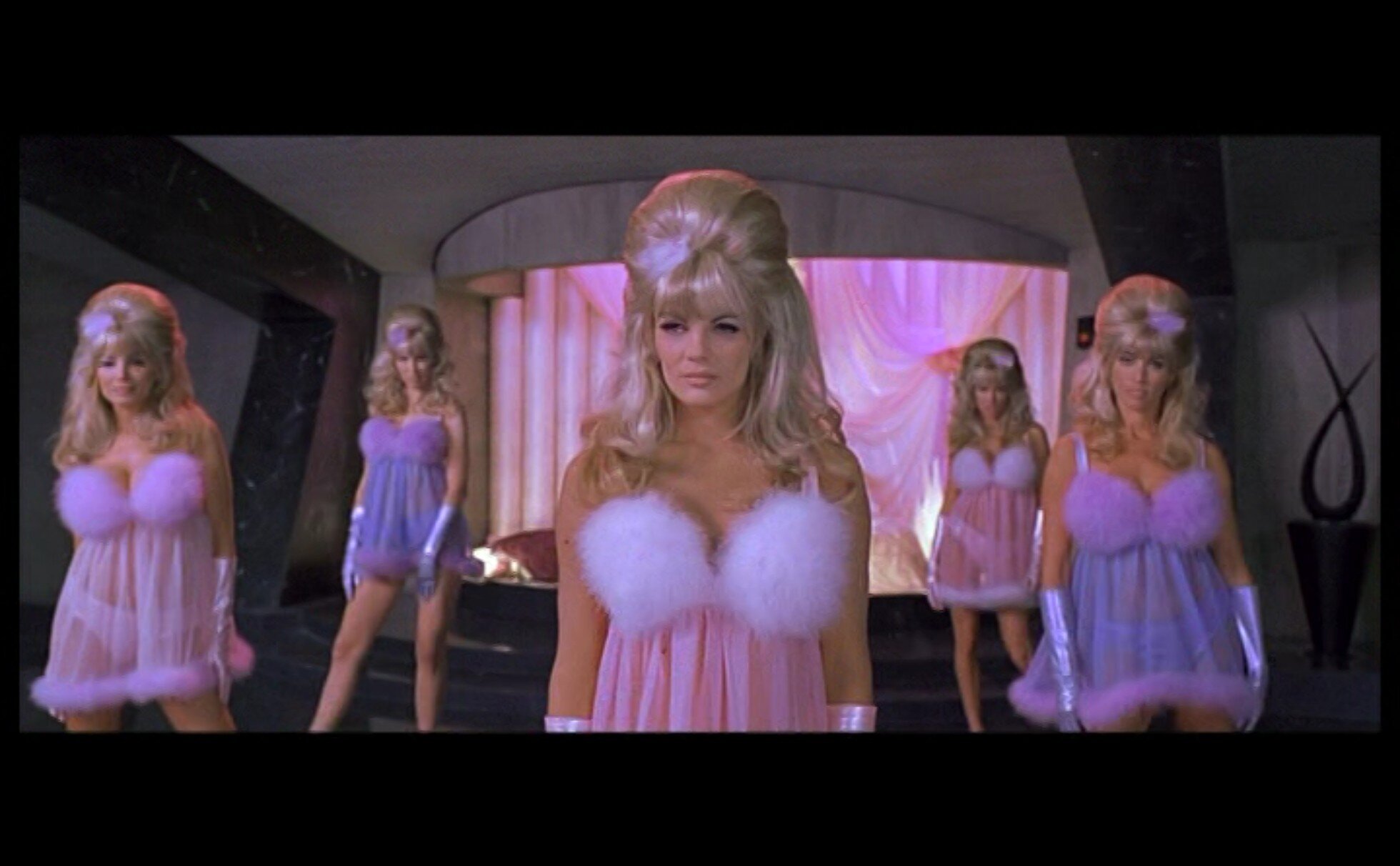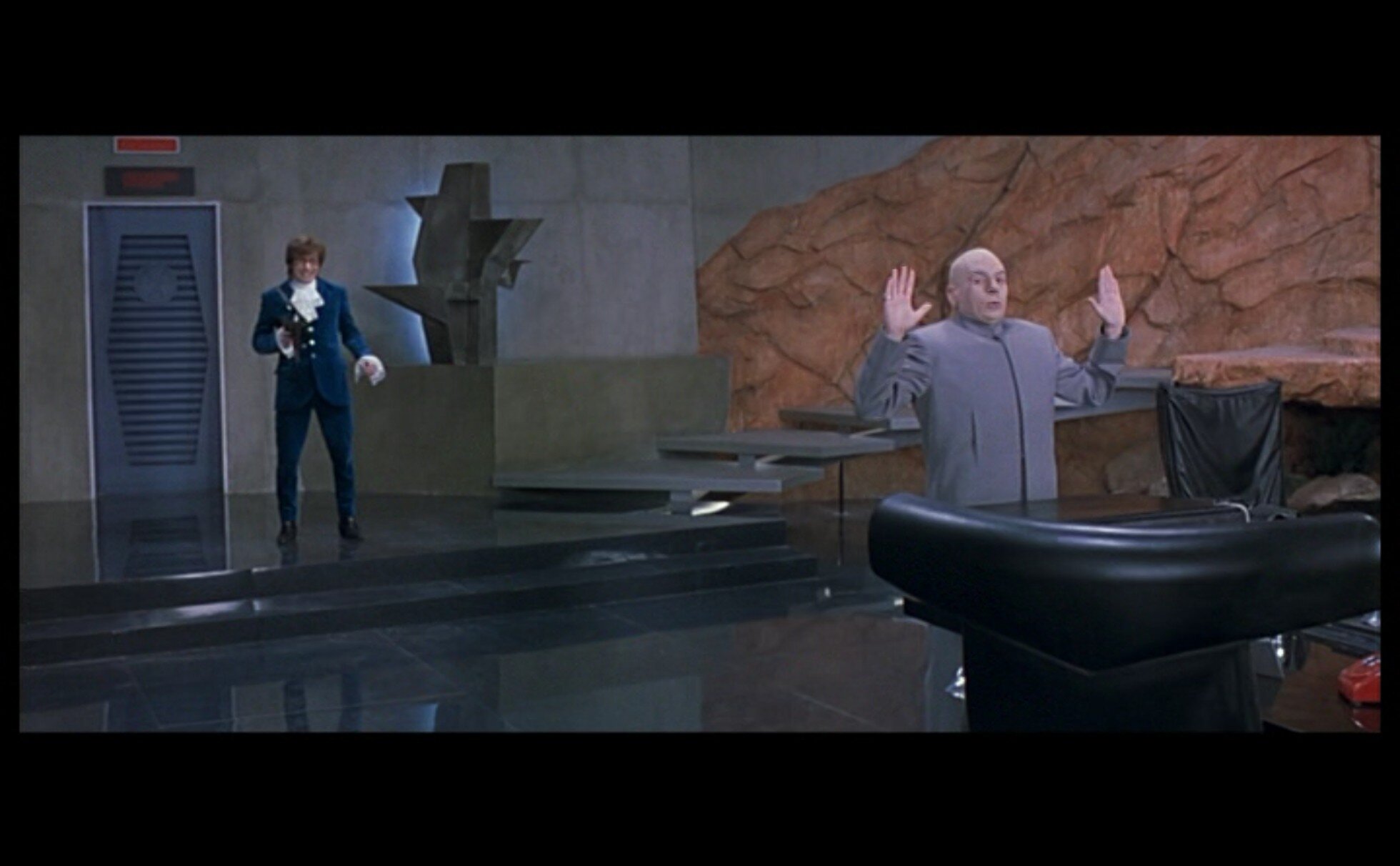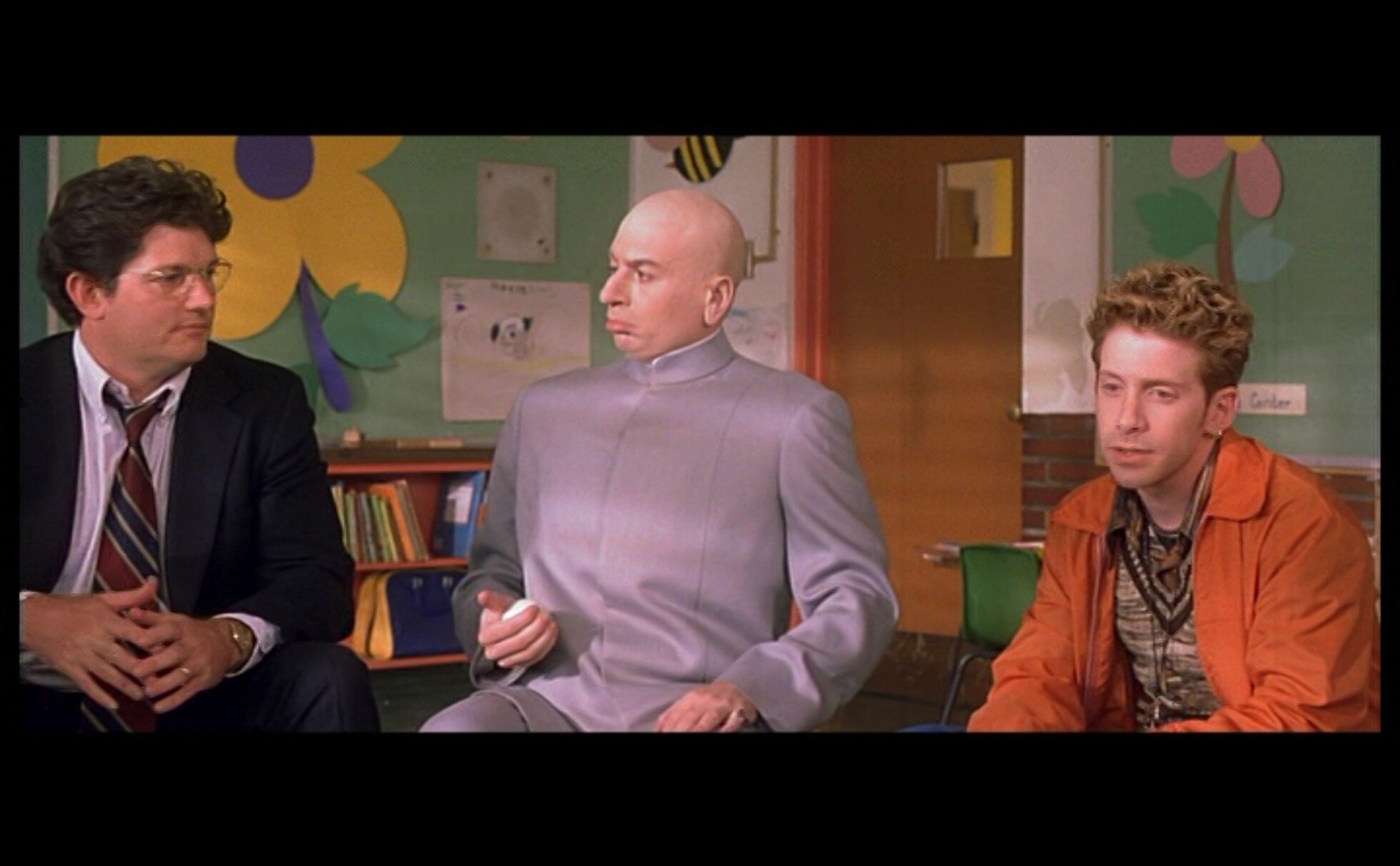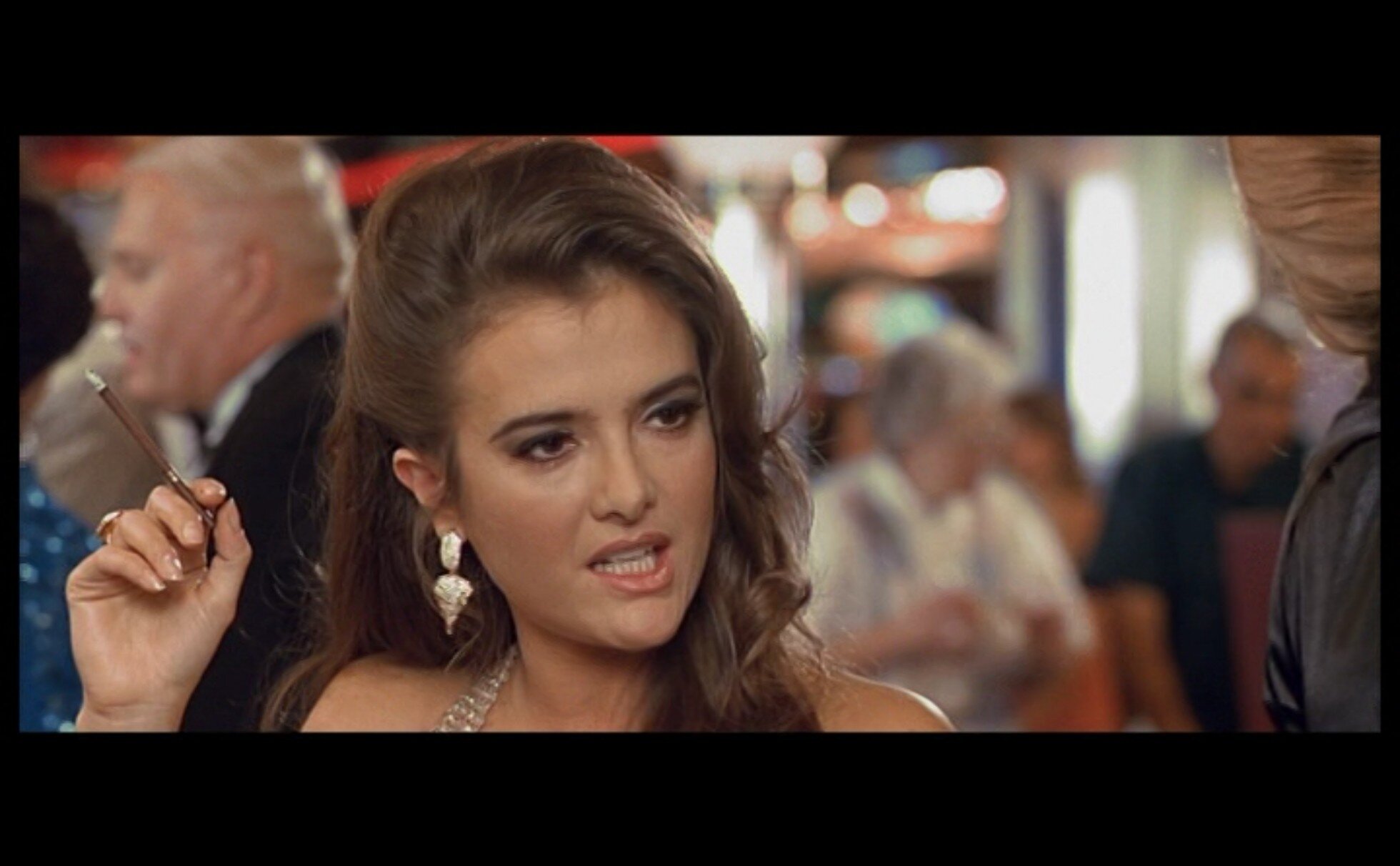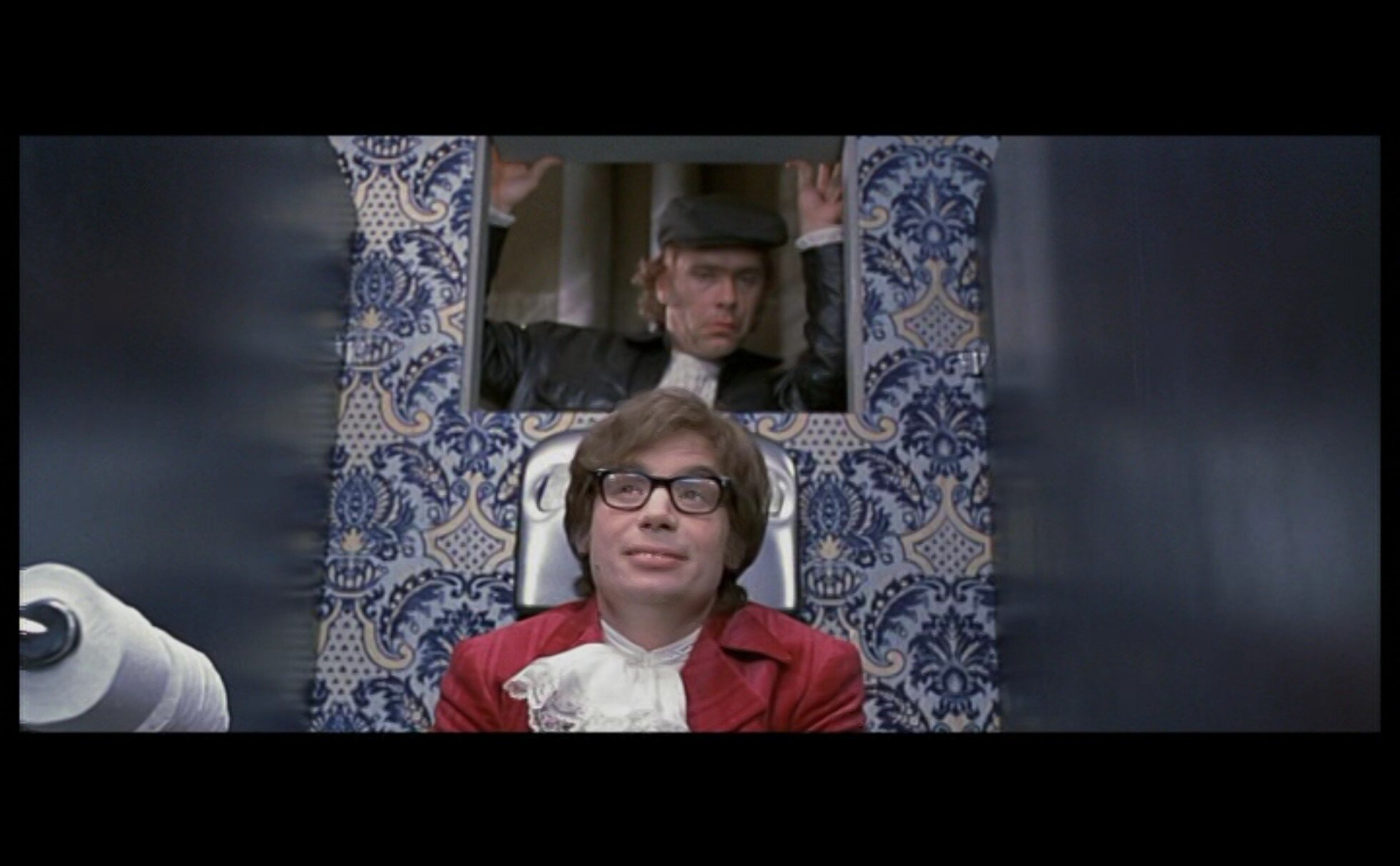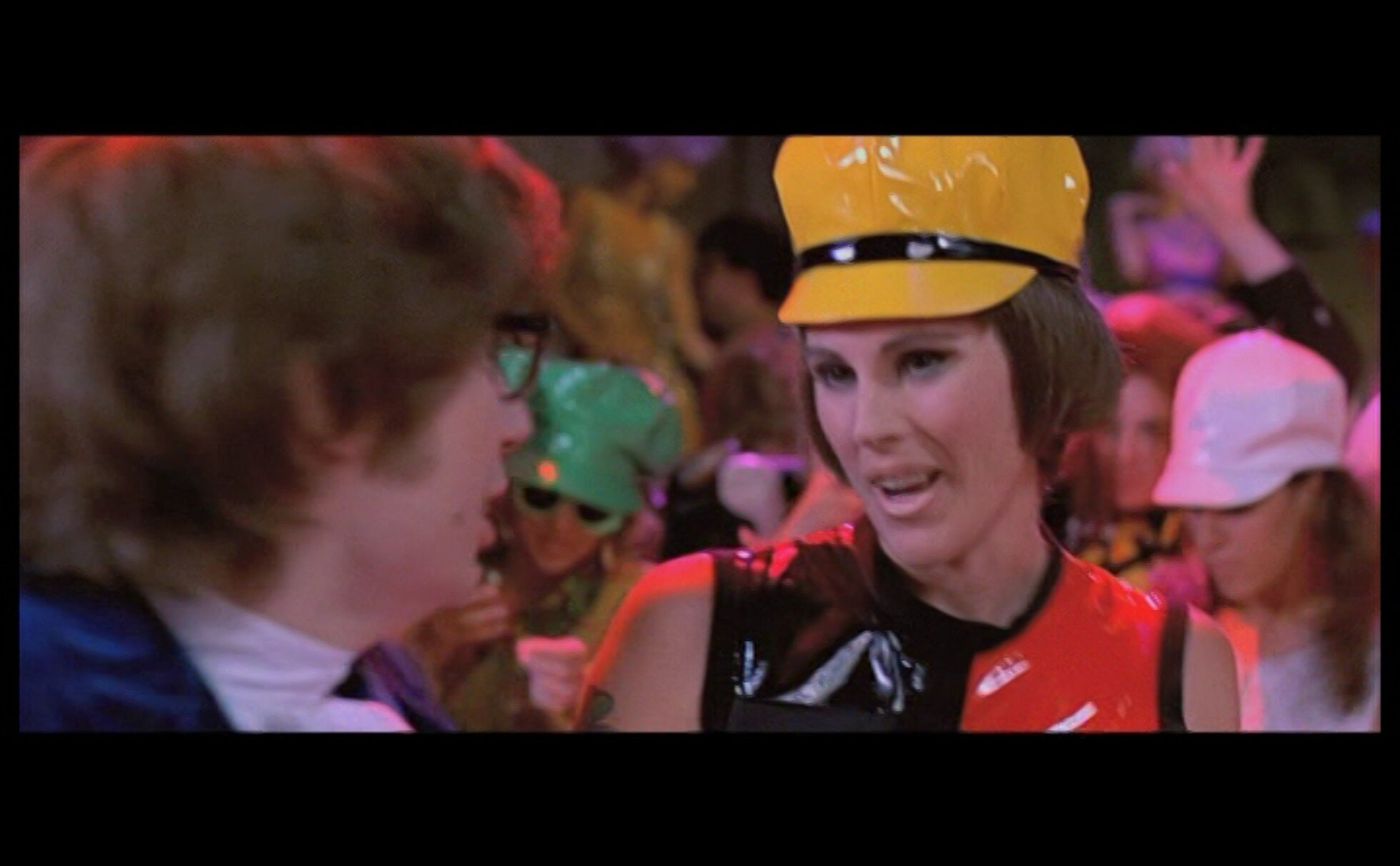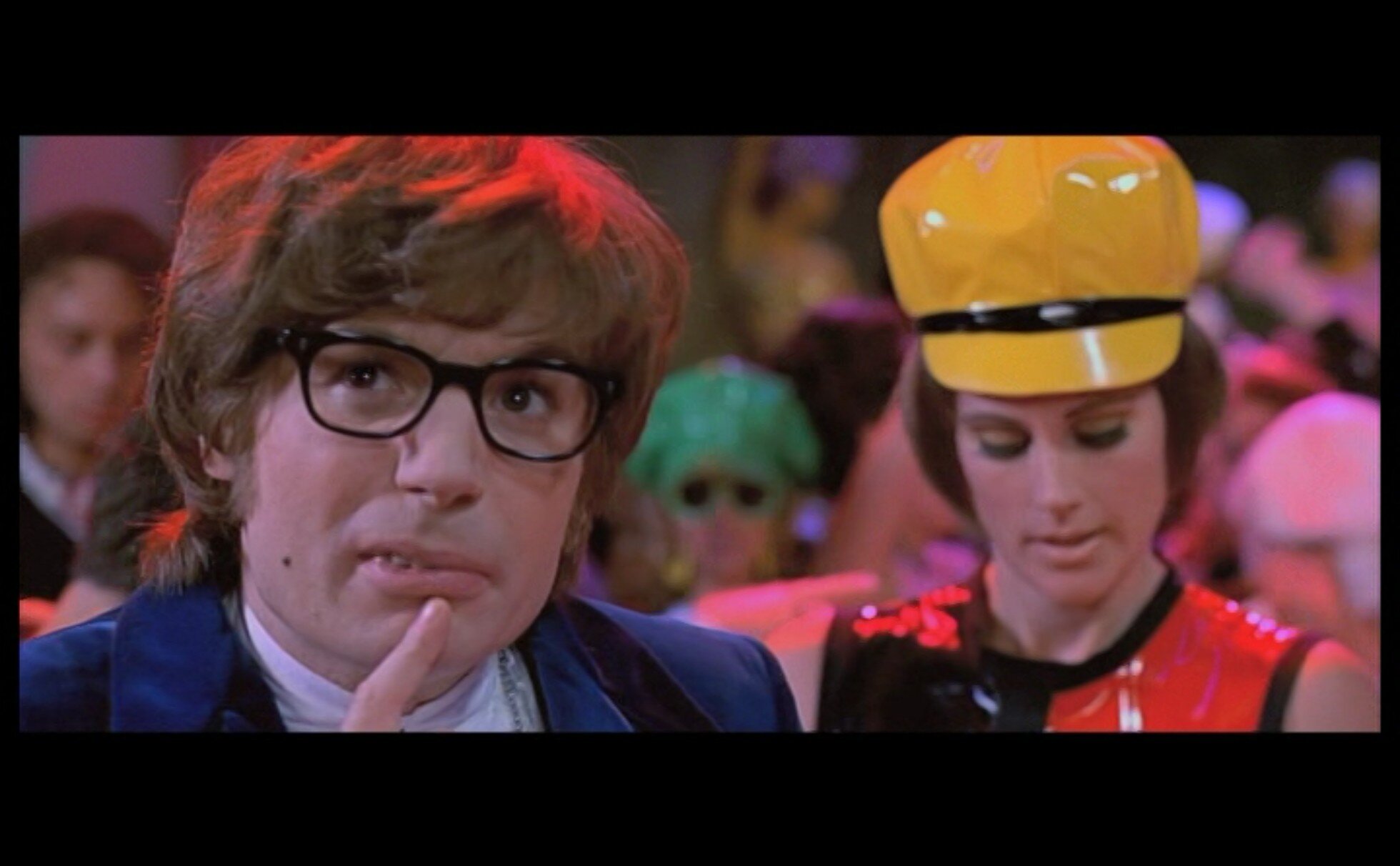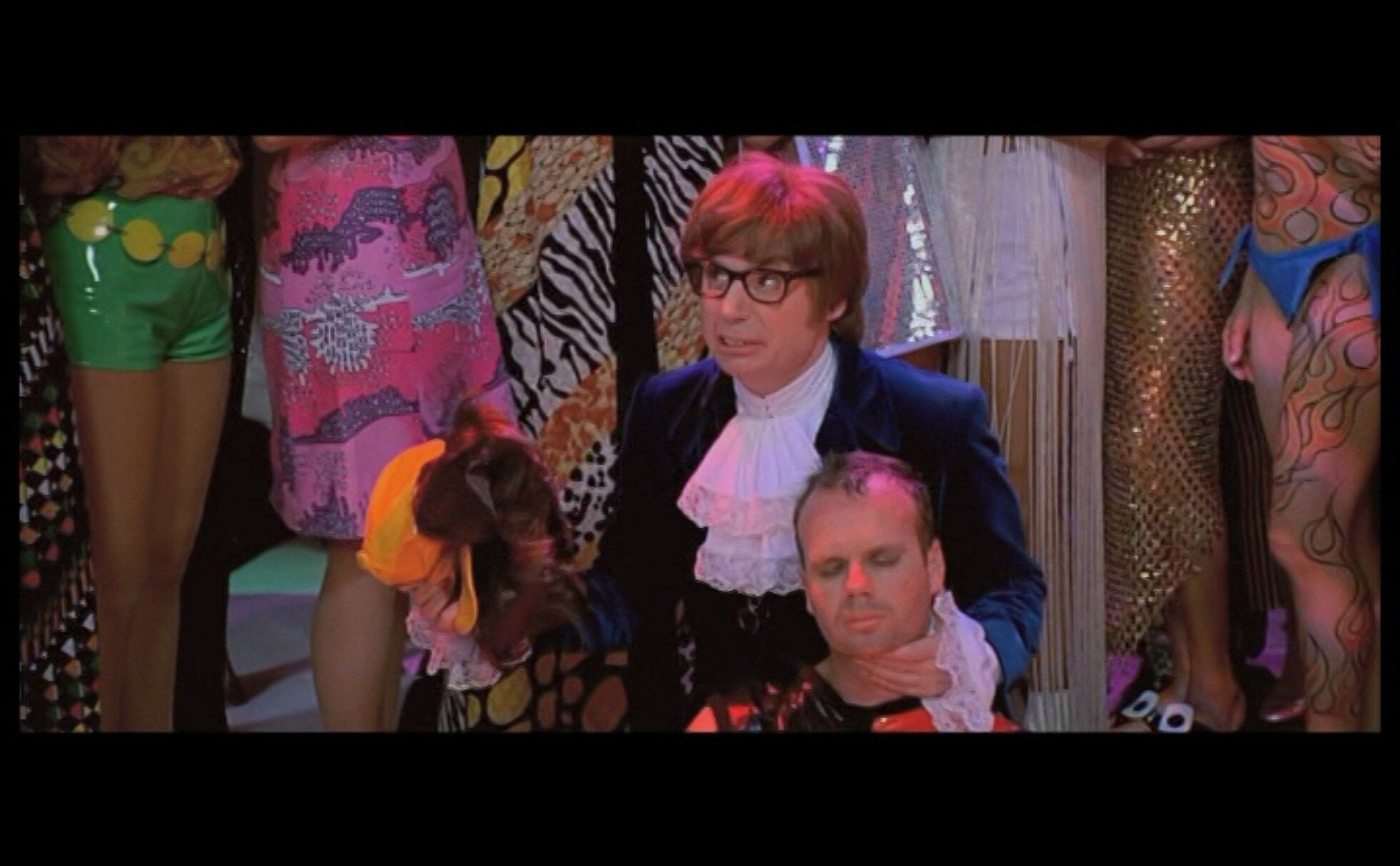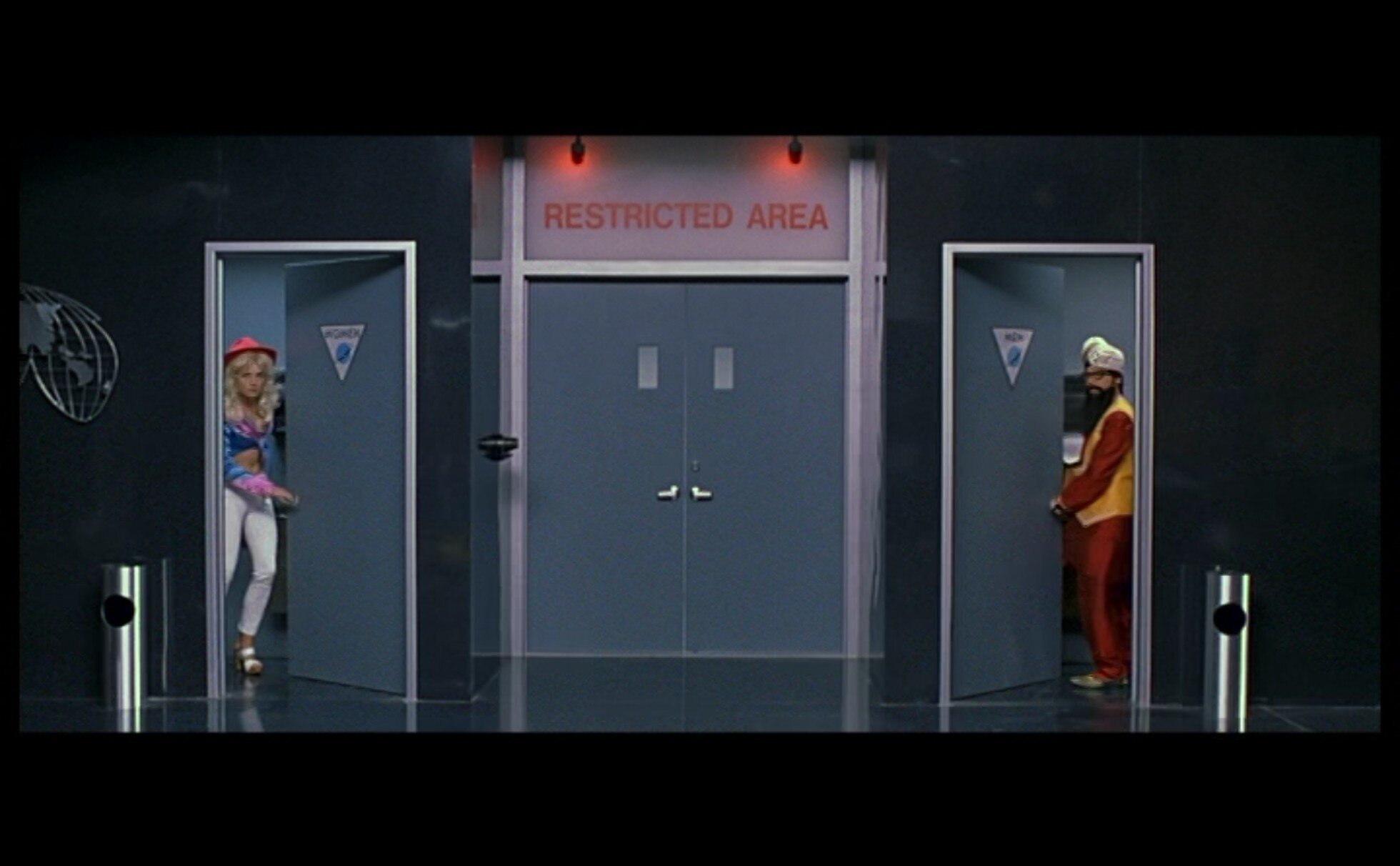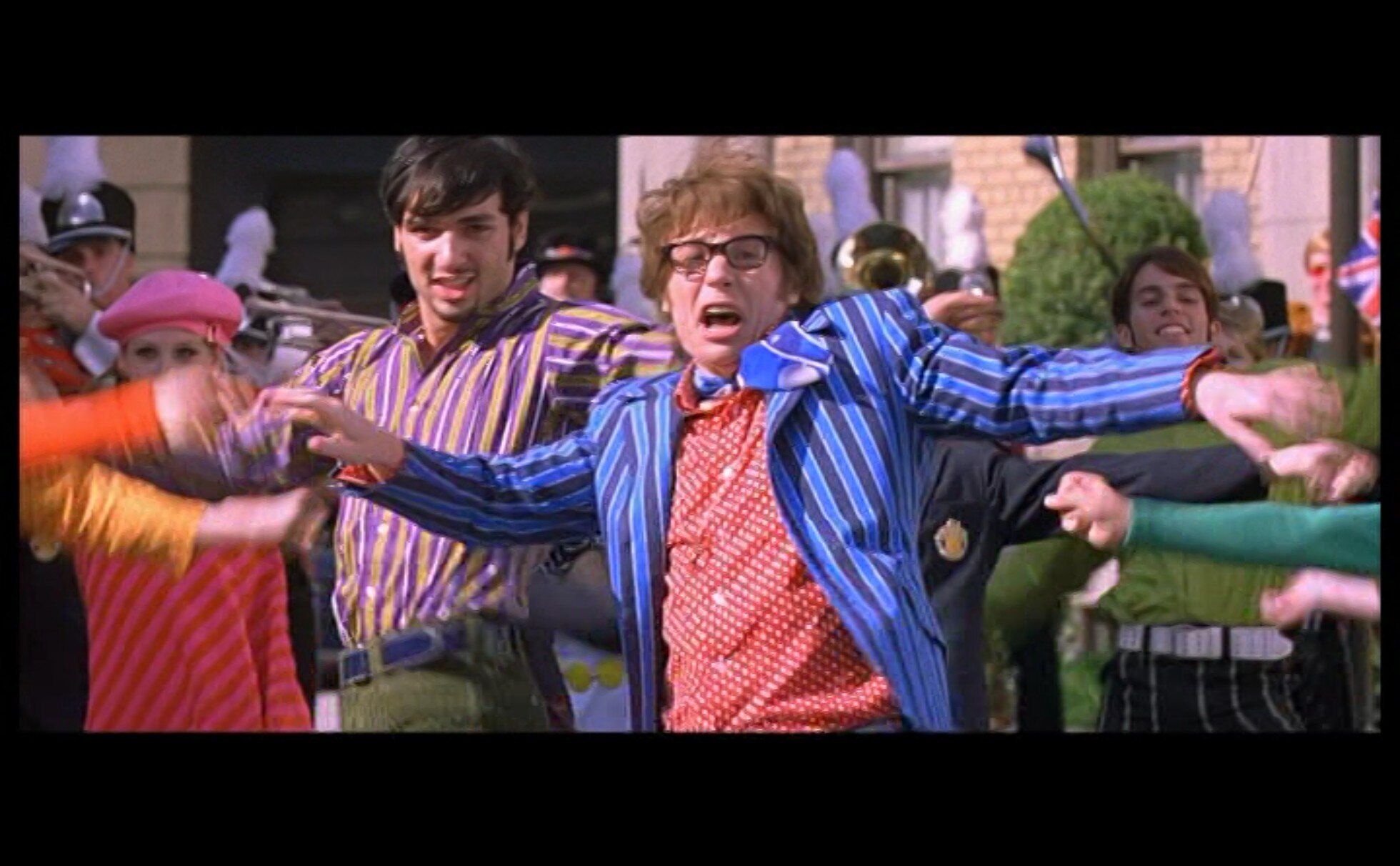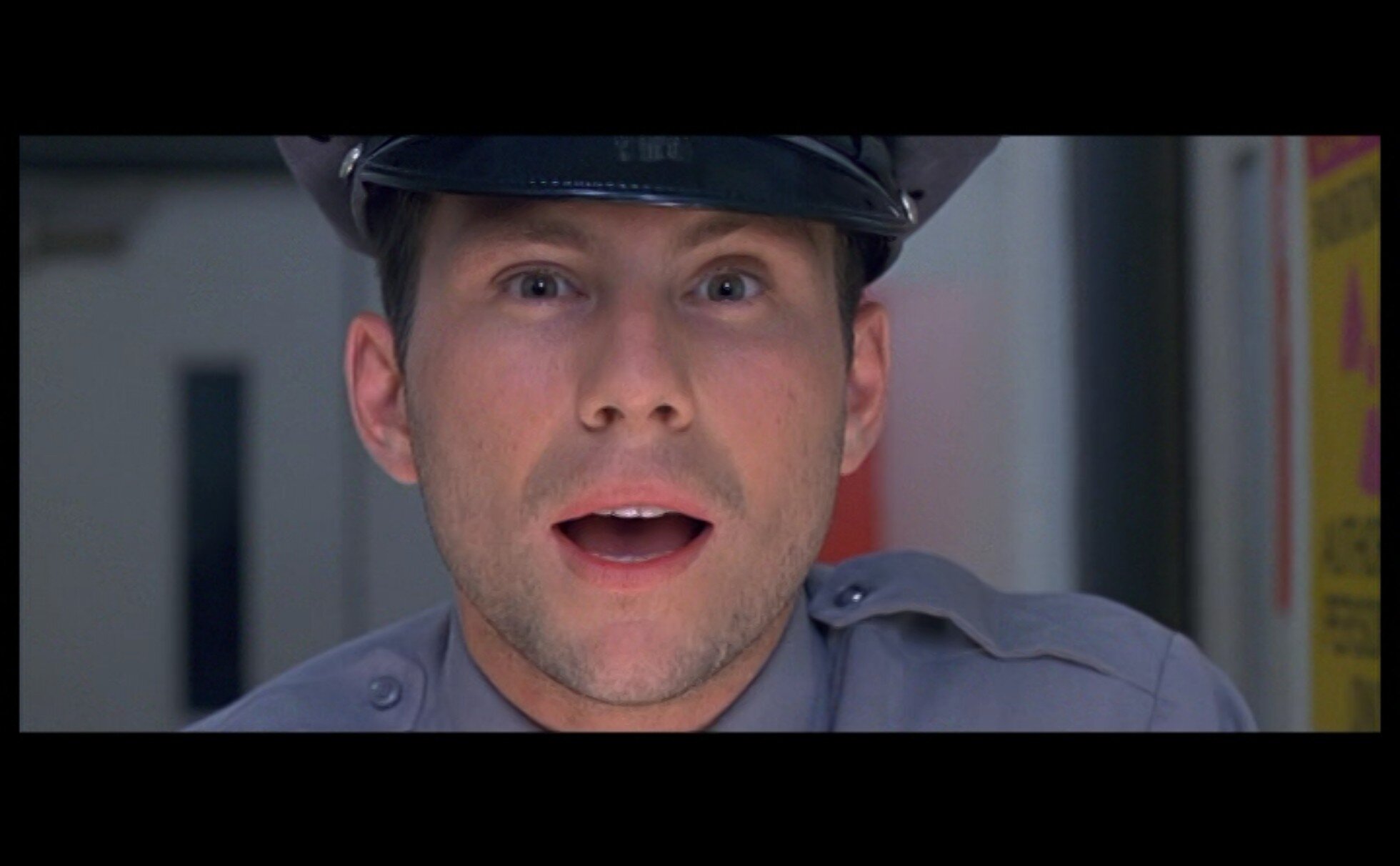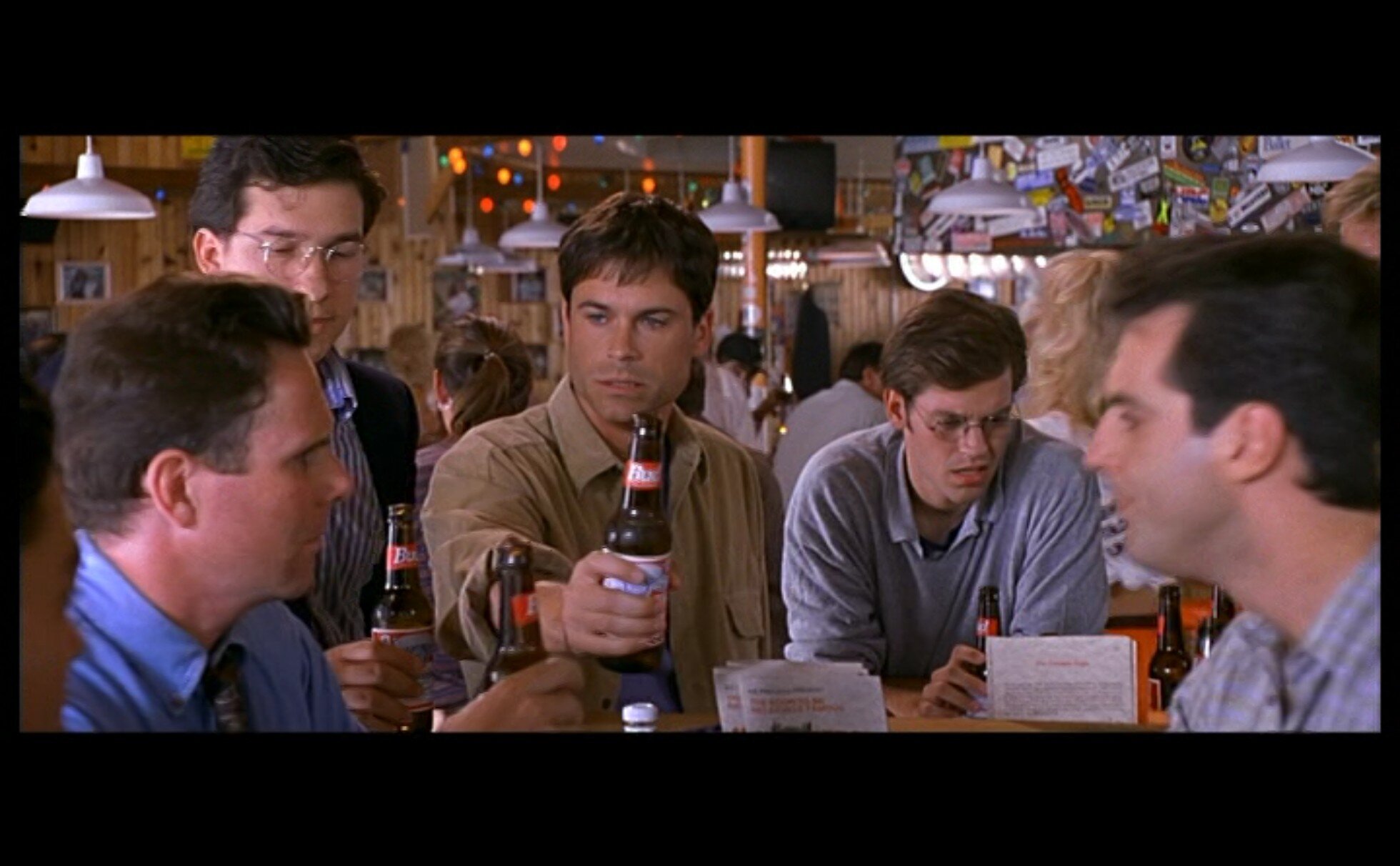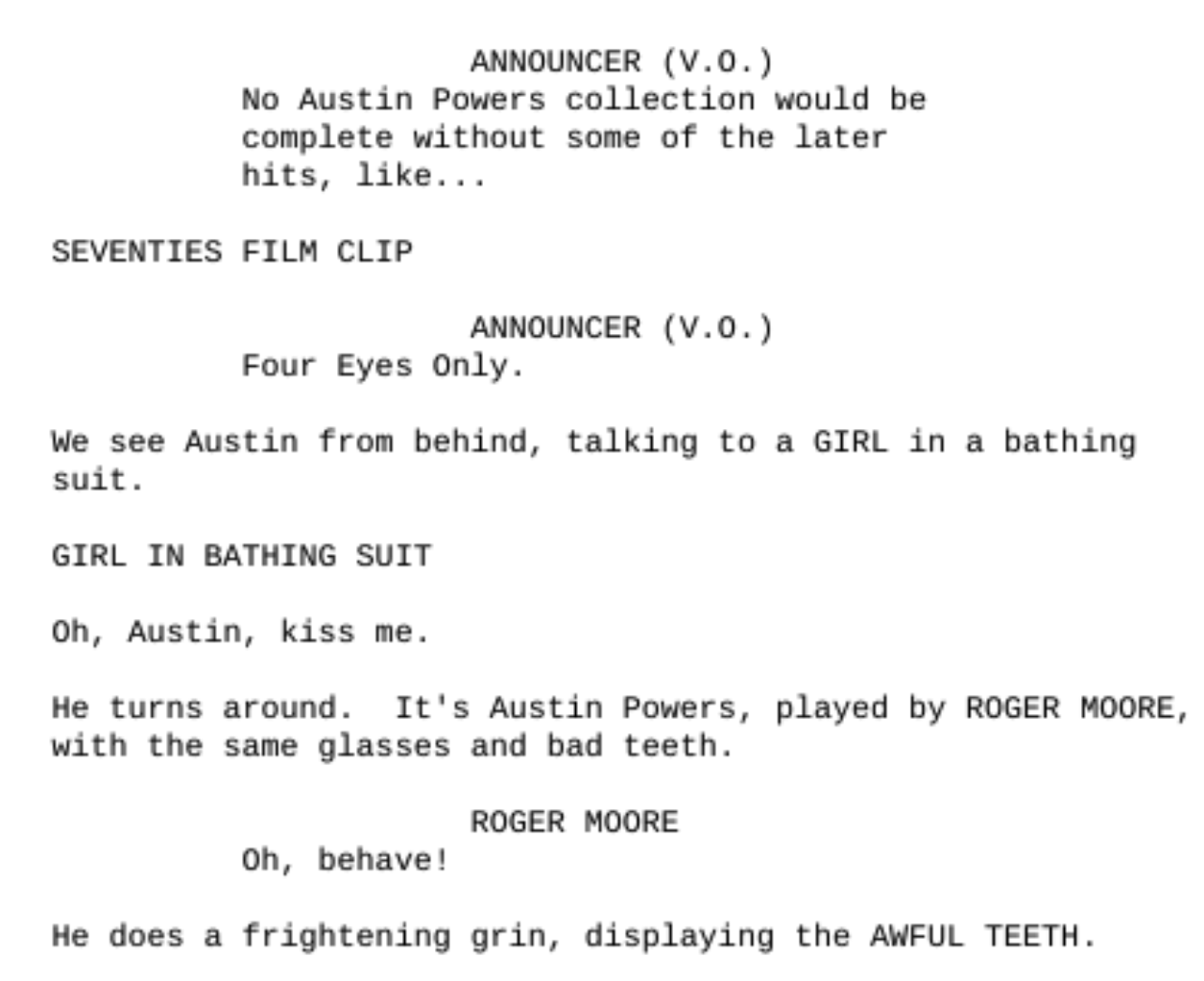Queer re-view: Austin Powers: International Man of Mystery
The better part of three decades has passed since Austin Powers first appeared on our screens, the amount of time which Austin and his nemesis, Dr. Evil, were frozen. Has time been kind? Is Powers still groovy? Does he swing or leave us unmoved? Is he the free-spirited antithesis of Bond (as a prolific 007 director claimed) or is he actually just a bit too well behaved?
If this is your first time reading a re-view on LicenceToQueer.com I recommend you read this first.
“My name is Richie Cunningham…”
In a 2002 interview, conducted only weeks ahead of the release of the third Austin Powers movie Goldmember, the director of four Bond films Guy Hamilton told Matthew Sweet that he saw Powers as “Bond's antithesis”. He reminisced that, on the sets of his Bond pictures, "I was always pushing to remind people that James Bond was Commander Bond, RN… he was a member of the establishment.” To illustrate, Sweet recalled the memorable episode in Goldfinger where he claims drinking inadequately chilled Champagne “as bad as listening to the Beatles without earmuffs!"
Bond has always been both simultaneously of his time and apart from it. Sometimes he’s been in front, but more often he’s been behind. Whereas the Connery films of the 1960s set popular trends, many of the Bond films have followed them (it took until the end credits of 1979’s Star Wars-instigated Moonraker for disco to finally make a foray into a Bond picture).
Being big in the Sixties and then having to adapt to survive in subsequent decades is not all Bond has in common with Austin Powers. They also share a sexuality which is queer. So is Powers really Bond’s ‘antithesis’?
Not long after we first meet Powers he’s hanging out in a club with someone possessing more than a passing resemblance to Andy Warhol (complete with Campbell’s soup can), the famous gay artist and film director. Later, he reveals that many of his friends - including queer people and allies - have passed away in the intervening decades. He’s certainly at home in a queer milieu.
Powers famously espouses ‘swinging’, which is unheternormative if we adhere to the definition of heteronormative as the socially-pervasive idea that ‘the only normal and natural relationship is between one many and one woman’. When he’s first unfrozen thirty years after his heyday and cautioned that “a lot's changed since 1967” he lays his philosophy for life bare:
“Well, as long as people are still having promiscuous sex with many anonymous partners without protection, while at the same time experimenting with mind-expanding drugs in a consequence-free environment, I'll be sound as a pound.”
Note the gender neutral ‘partners’. If Austin Powers: International Man of Mystery was made today, I have no doubt that Powers would not be confining himself to sex with women. As it is, he has no compunctions about sleeping with multiple female partners, often simultaneously, albeit not in the same room. When he returns from a liaison with the villainous Pussy Galore/Fiona Volpe/Helga Brandt representative Alotta Fagina, he gleefully tells the ‘Bond girl’ of the story, Vanessa Kensington, that he “sh*gged her rotten baby”. This is only subtly different to what happens in Bond. The difference is that Bond usually beds women concurrently, not at the same time. The Bond girl doesn’t get into his bed until right at the end, although technically it’s more often than not a boat in the Connery era, something referenced in a deleted ending to Austin Powers.
Bond gets THE girl only after the other girls have departed (usually terminally). Although Vanessa doesn’t succumb to Powers’ charms until the finale, she is clearly being positioned as ‘the one’ he will end up with when he has sex with Ms Fagina. And crucially with Bond, the good girls rarely find out about the preceding string of other women. For instance, Tracy doesn’t want to know about what Bond got up to in Piz Gloria. A notable exception is Melina in For Your Eyes Only, who does see Bond go off with Lisl, but the later scene where they talk about this was cut from the film.
Does all of this mean Austin Powers paints a queerer picture of sexuality than Bond? Not really. If anything, he’s more conventional than Bond. By the end, he has settled down with ‘the one’. He and Vanessa are married, although they are less inhibited than most couples, utterly unembarrassed to parade around their home naked while taking a video call from their boss.
These scenes, with body parts being concealed with various objects, became a hallmark of the Austin Powers films. Although they were apparently inspired by the opening titles of camp classic Barbarella (1968), there was not as much effort taken to make sure everything was concealed. The Austin Powers versions are very British, the cinematic equivalent of a ‘saucy’ seaside postcard. They also embody the dichotomy at the heart of this franchise: it wants to celebrate free-loving ‘swinging’ heteronormativity as some kind of ideal but make it palatable for the (presumed to be) more conservative audience. It both wants to have it’s gigantic sausage and eat it.
It’s the same thing with Bond, which has a similar sexual wish-fulfilment at its core, but always makes sure it ends reassuringly heteronormatively. A giant unspoken footnote overhangs a Bond ending however: we know Bond will be unattached again by the beginning of the next adventure. No Time To Die is the one and only exception. And also Quantum of Solace if you see Vesper Lynd’s presence haunting Bond. The only time Bond marries, it is short lived. And although there are callbacks to his marriage to Tracy (obliquely in Diamonds Are Forever; fleetingly in The Spy Who Loved Me, For Your Eyes Only, Licence To Kill, The World Is Not Enough), none of these impacts on the story in any significant way. When Austin Powers returned, in The Spy Who Sh*agged Me, the film nailed into Bondian colours to its mast almost immediately by killing off Vanessa in the pre-titles sequence, with Austin jubilantly telling the audience “I’m single again!”
Even when I saw it for the first time in cinemas in 1999, this seemed to be in somewhat poor taste, and I desperately hope No Time To Die does not go down a similarly lazy route of killing off or unceremoniously sidelining its female lead. It will be especially interesting to see if Madeleine Swann gets to swan off and do her own thing - perhaps seeing other people, as Bond will no doubt do - and perhaps both of them ultimately reconciling without feeling guilty about what (and who) they have both been through.
Visually-speaking, the most Austin has in common with Connery’s Bond is his impressive chest hair. But he’s also a melange of other quintessentially 60s characters; Jason King, played by gay actor Peter Wyngarde, influences his fashion sense; his photographer persona is taken from Blow Out and the Matt Helm movies; his glasses are from Harry Palmer (and/or Peter Sellers’ Evelyn Tremble character in the 1967 Casino Royale). The British reputation for having bad teeth was already a source of comedy for Myers’: he had written a Saturday Night Live featuring a spoof toothpaste commercial which played with the same idea.
Austin is supposed to be vaguely pathetic. He is, to quote Dr Evil’s summation, “an aging hipster”. But it’s possible to root for him because he’s a fish out of water throwback, even an underdog at times. While it’s entirely feasible to find many of his attitudes - towards women in particular - archaic (if not downright offensive), he’s also an anarchic spirit. He represents that tension in all of us: adhere to convention or flout society’s dictates. And he’s surprisingly fragile. He does wear a symbol around his neck identifying himself as a man ♂ as a way of advertising his sexual potency. But we know, from his Swedish penis-enlarger pump, which he attempts to disown, despite having written a book about it, that there’s an element of shame and insecurity about his ability to satisfy a partner. The symbol is false advertising.
Such symbols, incidentally, were first used by naturalist Carl Linnaeus in the 1750s to indicate whether plants were male, female ♀ or hermaphroditic [x], as most plants are. With such variety in nature, it’s bewildering to me that so many human being cling on for dear life to binary conceptions of sex and gender.
When I first saw Austin Powers on VHS tape in the late 90s I found it to be a subversive, taboo-breaking experience. Admittedly, I was only 15 years old (and I was a relatively shy, sheltered, 15 year old). My younger (but usually more mature) sister and me watched it together and laughed like drains throughout. And then we rewound the tape and watched it all over again from the start, dragging our parents along for the ride. They were not as amused as we were, perhaps because, being born in the mid-late 1950s, they remembered the 1960s the first time around.
When I rewatched it with my husband recently we both found the film funny, but not in the slightest bit subversive. To be frank, it felt quaint and naively innocent. Either we, or the world, had grown up quite a bit.
Back when I first saw it with my sister though, a spirit of anarchism seemed to pervade the film. In hindsight, I can see that it’s more to do with the film’s freewheeling structure than its ‘saucy’ portrayal of sex. Like most of the best cinematic comedies, the needs of a coherent story are subservient to the need to make the audience laugh.
Largely due to word of mouth following the video release, the film became a cultural phenomenon and spawned (there’s Austin’s lack of protection!) two sequels. The ad campaign for the second film, The Spy Who Sh*gged Me, ameliorated the word ‘sh*g’ to the extent it could be featured, without censorship, on billboards and on the sides of buses (although you’ll note I’ve wimped out and starred it because the process is entirely reversible and I’ve not heard this word in the vernacular recently!).
Goldmember conferred a certain respectability on the series, eschewing some of the more outre elements of the previous two (especially the scatological humour of the second) and spending nowhere near enough time in the 1970s. Instead of casting its satirical net across another decade, it got caught up in its own continuity, turning it into a family drama. It’s funny how the Bond franchise has ended up treading similar ground in recent years (see Villains, below).
Guy Hamilton is right, to an extent, to maintain that the Powers character is the antithesis of 007, although it’s supremely ironic that the parts that Austin Powers takes wholesale from Bond are mostly ripped from the period of films inaugurated by Hamilton. It struck me on my recent rewatch that almost all of what we think of as the Austin Powers aesthetic was taken wholesale from five Bond films: Dr. No, Goldfinger (directed by Hamilton), Thunderball, You Only Live Twice and Diamonds Are Forever (also by Hamilton).
Yes, there are characters and situations from other films, but the style is resolutely those five, especially Diamonds, even down to the Las Vegas setting and the Eastern European-accented announcer (“...and counting”). Austin Powers also leans heavily on the 1967 ‘unofficial’ Casino Royale. Austin enjoys a spinning bed a la Peter Sellers. Royale’s composer Burt Bacharach makes appearances - on the soundtrack and on screen. Myers himself has said in interviews that hearing on the radio Bacharach’s song from the 1967 Casino Royale, The Look of Love, sang by the lesbian Dusty Springfield, was the thing that started the thought process that led to him creating Austin Powers.
Most notable are the killer Fembots (a riff on Casino Royale’s robotic doppelgangers) who attempt to seduce Powers. This mimics - and to an extent gender-reverses - a scene where Coop (one of the film’s seven 007s - it’s a long story) has to resist the charms of a room full of beautiful women. Unlike Coop, who remains fully clothed, Austin defeats the Fembots by performing a striptease, turning himself into an object of lust to the tune of the Divinyls’ ode to onanism, I Touch Myself.
It’s interesting that Myers chose 1967 to be the time we first encounter Austin Powers. It was a tumultuous year - socially, culturally and politically. Although it’s far too reductive to see any particular year as a ‘turning point’ in history - behaviours and attitudes do not change en masse across a society - 1967 is more of a milestone than most, laying the ground for what some have labelled ‘the year of revolt’, 1968. By 1967, protests against the Vietnam War had already broken out around the world. In the UK, homosexuality was partially decriminalised in the UK so love became a bit freer - if you were over 21 at least. And of course it was the year the first James Bond, Sean Connery, stepped down from playing the character who had set trends across popular culture.
The reality is that, for many, the biggest changes to their lives were cultural rather than social. The Sixties did not swing for everybody. I recall my parents saying, after we had finished watching that VHS tape, that ‘the Sixties weren’t really like that’. Perhaps this is why they struggled to buy into it compared with my sister and me. For people like us, born in the Thatcher-dominated 1980s, it seemed an impossibly libertarian period. Although it had problems (Austin Powers mentions some of these in passing), the 1960s on the screen seemed alive with possibilities. This contrast with what many see as humdrum present day reality is at the heart of many people’s rose-tinted nostalgia for the 1960s - and perhaps why the recent Bond films are obsessed with looking backwards rather than forward.
Austin’s Allies. Well, ally.
Basil Exposition performs double duty as both Austin Powers’ M and Q. His only non-work relationship is with his mother who he appears to care a great deal for. It’s a stereotype that gay men are close to their mothers so treat it with the caution it deserves. Unsurprisingly, for a character whose utilitarian role is their name (an aptronym even Charles Dickens would have baulked at), he doesn’t reveal much about himself; he’s just there to move the story forward. He’s played by Michael York, a straight man famous for being the lead in the musical film Cabaret which depicts the fictionalised experiences of Christopher Isherwood, who was bisexual, alongside queer icon Liza Minneli and gay man Joel Grey.
Shady Characters: Villains
Having the same actor - Mike Myers - play both hero and villain brings the subtext of the Bond series right into the text of Austin Powers - making it metatextual even. When Mike Myers as Dr. Evil tells Mike Myers as Powers “we’re not so different, you and I”, the film is making an explicit comment on the tendency, right from Dr. No onwards, for the villains to be the ‘dark side’ of Bond. If anything, the Bond films which have followed the Austin Powers series have almost taken this to parodic extremes themselves. One could even credit Austin Powers in Goldmember with directly inspiring Spectre, thirteen years later. In both films the villain and hero are revealed to be brothers, although in there’s no biological connection between Bond and Blofeld, the film still makes its case for a fraternal relationship gone awry.
Doubling of any kind always carries a queer frisson, especially in a visual medium like cinema. But the similarities between Bond and his villains, like Powers and Evil, are more than skin deep. When No Time To Die’s Safin taunts Bond by telling him “I could be speaking to my own reflection”, he’s referring to their shared profession: killing to “make the world a better place”. Bond does not take kindly to being lumped together with a mass murdering psychopath. Similarly, Dr. Evil and Austin Powers have more in common than either of them would like to admit. The main stumbling block in the way of Dr. Evil’s plan is his lack of understanding of the modern world. Difficulties with getting to grips with inflation aside (“one hundred… billion (?) dollars!”), he has to contend with modern approaches to everything, including parenting. In therapy with his son Scott he reveals his own, very different, childhood. He tells the therapy group that his father had a “penchant for buggery” and this is presented without judgement (although it’s clearly intended to get a laugh from the audience).
Amongst the various past traumas that might have set him on the path to adopting his ‘Evil’ guise, the detail which disgusts all of the other dads and sons present is his ritualistic shaving of his scrotum. In the course of researching this article I discovered that the literature on, what academics refer to as ‘pubic hair depilation’ has increased exponentially over the last decade or so, mirroring the decline in the amount of pubic hair itself. As the hair gets taken away, the research into why this is happening proliferates, trying to explain why it is happening! A 2017 paper concluded that “pubic hair grooming is common among men aged 18 to 65 years in the United States” with “younger ages” being “associated with greater rates of pubic hair grooming”. Would the lads and dads group of the kind depicted in Austin Powers find the topic of conversation so unpalatable today? (Probably yes. I imagine in most households, discussion of what advertisers now call ‘manscaping’ is still not considered a suitable topic for the dinner table). Interestingly (well, I find it interesting) it appears to be the gays to be responsible for promoting this ideal of hairlessness. In the 90s, it was mostly gay men who shaved their delicate regions, but imagery of male models (often shot by gay photographers), could have influenced straight consumers.
Notably, Dr Evil himself is almost entirely hairless - at least the parts that show (we presume - but, blessedly, are never shown, that the collars and cuffs match). Evil’s hairlessness makes him contrast starkly with his hirsute, swinging nemesis. [For more on the significance of hair - if you’ve not yet had enough - see Girls, below]
In the Bond + villain tradition, both Powers and Evil are compensating for a perceived sense of not being masculine enough, with the locus of their insecurities being found in an all-too-conventional location. In addition to the penis-pump, Powers is intimidated by the size of Vanessa’s gun. Evil, like Blofeld in You Only Live Twice, has a predilection for conspicuously oversized phallic machinery. He even intends to use his drill (which looks suspiciously like the sea-drill from Tomorrow Never Dies, released the same year) to “penetrate” the Earth’s crust in order to set off volcanoes. Once again, Myers has burrowed beneath the surface of Bond and brought the subtext into the light.
Also like Blofeld, Evil is something of a blank slate when it comes to his romantic and sexual inclinations. Although this does receive more focus in the second Austin Powers adventure, next to nothing is revealed in this first film. Like a gay dad starting a family through surrogacy, his conception of Scott occurs through IVF using a sample of his semen he left behind before being frozen in time. While it’s revealed in The Spy Who Sh*gged Me that Scott’s mother was someone he might also have romantic feelings for, this is a retcon of the sort the recent Bond films are fond of!
In my view, continuity is overrated anyway. So when we see Number 2 trying to escape Dr. Evil’s lair with a Fembot crammed into a suitcase, we shouldn’t try to ‘square’ this apparent heterosexuality (although unheteronormative because: intercourse with a killer robot) with his broadened horizons in the second film. In The Spy Who Sh*gged Me, Number 2 memorably ends up in bed with the younger version of himself, which could make him autosexual - someone who is generally attracted to themselves more than other people. It could also suggest he’s a narcissist, a trait which many of the queerest Bond villains have in spades. There’s certainly enough evidence in the first film for this; his reason for turning on Dr. Evil is his bitterness that he will lose his pre-eminence in the business world - and specifically not get to see his image on the cover of Forbes.
Frau Farbissina is modelled closely on one of the fan favourite queer characters in the Bond series: Rosa Klebb. Unlike Klebb, however, she does appear (based mostly on the second film) to prefer men to women (even if a deleted scene from this first film claims she is dating Courtney Love). As a teenager I found the joke about her being the founder of the militant wing of the Salvation Army to be one of the most sophisticated and witty in the film. But the charitable organisation, which undoubtedly does a lot of good, has had its saintly reputation muddied by a number of its leaders making discriminatory comments about LGBTQ+ people. It sort of takes the wind out of the joke really.
Still just as funny to me as the day I first saw Austin Powers is Alotta Fagina, the epitome of the femme fatale character with an eyebrow-raising name. Like Xenia Onatopp, she is partial to a cigar. I agonised for some time whether to treat her as one of the Girls, but she is unrepentently an adversary. She’s not even a sort-of ally like Pola Ivanova in A View To A Kill (although both have a thing for coitus in hot tubs). And unlike her sex-organ-appllation-progenitors Pussy Galore and Octopussy, she remains unredeemed by the end of the film.
Patty O’Brien doesn’t even make it to the end of the film: he meets his Waterloo in the water closet, with Austin drowning Patty in the toilet bowl after he appears from an overhead hatch, an (unintentional?) homage to Pierce Brosnan’s entrance in GoldenEye. Are we here again: Men’s bathrooms as a hotbed of queer activity? Not really. The queerest thing about Patty is the mix-up about Lucky Charms on the part of Frau and Evil, although Patty himself does not appear to be a fan of the world’s Rainbowest cereal.
According to at least one report, it wasn’t a brick that was thrown by Marsha P. Johnson, the trans woman now widely credited with starting off the Stonewall riots: it was a shoe. Who throws a shoe? Odd jobber Random Task and queer hero Marsha P. Johnson, that’s who.
You go gurrrls!
“It’s a man, man” Powers explains, shortly after punching someone who, in the previous shot was, to all appearances, a woman. The unconscious figure Austin lifts off the floor has a very obvious five o’clock stubble shadow. They are very obviously intended to be what we would conventionally label a ‘man’ (man).
Having seen this ‘it’s a man” quote used to attack trans people a few times online, I was almost afraid to revisit Austin Powers. Would the scene be tasteless in its original context? Views my vary, but I think not. The joke is that the filmmakers have not even tried to disguise the swapping of the actor, in the same way that the early Bond films would struggle to disguise male stunt people when they were playing women. The situation is reversed here: the female actor (stunt person?) has the potentially dangerous role, risking being punched in the face, and the male actor has to act passively.
It’s arguably more disconcerting when the joke is repeated later in the film when Powers encounters Basil’s elderly mother and gives her repeated punches to the face. But I would contend that the butt of the joke is Powers and his narrow conception of what constitutes a ‘woman’ and a ‘man’. He’s the one still stuck with his fragile, all-too-binary mental model of gender.
In Austin’s world, manliness means hairiness. As we saw with Dr. Evil’s baldness (on his head and elsewhere - see above), an absence of hair is emasculating. In our real world, hair is always an interesting signifier. Some queer women find keeping their hair helps them to affirm their identities.
The first female lead character we encounter is Mrs Kensington, clad in a catsuit that Emma Peel would be proud to wear. This raises the possibility that Powers might be a Steed-like character, someone Kensington might have sexual tension with but with who consummation is probably not going to be on the cards. Like Mrs Peel, she is married to someone else, although it’s not confirmed until later in the film that she and Powers were strictly platonic. In Emma Peel’s case, her husband is presumed to be dead and her relationship with Steed is strictly professional. In Austin Powers, the lack of sexual history between Powers and Mrs Kensington always rings untrue to me - a case of the filmmakers shying away from too many awkward questions perhaps, considering that Powers’ main relationship will be with Kensington’s daughter?
On first appearance, Vanessa Kensington falls into the category of the ludicrously attractive woman given a pair of glasses to make her look nerdy and therefore mildly less attractive. Is Powers spoofing this trope or merely repeating it? The film constantly treads this fine line. On the basis that it’s done consciously, the story wastes little time getting her into a little black dress. But her ‘final form’, her fully-realised-self, is as an action heroine in her mother’s (and Emma Peel’s mould), swapping the black dress for a similarly-hued cat-suit. How many films have a gender reversal of this trajectory? It’s not many. The one that always springs to mind is Bringing Up Baby, with David’s (Cary Grant) straight-laced life being turned upside down by the free-spirited force of nature that is Susan (Katharine Hepburn).
The ensuing epilogue to Austin Powers shows Vanessa to have embraced being groovy, unembarrassed about her nakedness while on the video call to Basil Exposition. The “bug” which has been up her “a*se”, for the majority of the film has died and she’s no longer saddled with the responsibility of being the ‘straight’ woman to the free-wheeling Powers because - the film wants us to think - she’s now just like him. But only because she has managed to make him conform to a monogamous ideal. No wonder she has to die in the pre-titles sequence of the next film! Bond fans often speculate what it would have been like to end On Her Majesty’s Secret Service on a high and have Tracy killed off at the start of Diamonds Are Forever. The Austin Powers films gives us a glimpse of that.
Camp (as Dr. Christmas Jones)
Susan Sontag famously observed that the purest Camp is unintentional. By that measure, Austin Powers is not very Camp, as everything was surely planned. However, in the tradition of all of my queer re-views, here are the bits - the fun footnotes - that didn’t fit in the other sections.
“I can’t believe Liberace was gay.” The performer, for whom the adjective ‘flamboyant’ seems apt for once, and not just a euphemism for ‘gay’, never came out and went to great lengths to put people off the scent. In 1959, Liberace took a British tabloid newspaper to court when a columnist described him as "the pinnacle of masculine, feminine, and neuter... fruit-flavoured, mincing, ice-covered heap of mother love". He cultivated a conservative public image which would ensure he was a success with middle America, making friends with President Reagan and even appearing on a 1983 James Bond TV special celebrating the franchise’s first 21 years. Even so, it’s difficult to imagine one of his close acquaintances - who it’s implied Austin may have been - not knowing the truth.
Another of Austin’s close acquaintances who has passed away by the time he awakes in 1997 is queer icon Mama Cass. Jenifer Gonsalves says:
“Despite not being part of the LGBTQIA+ community herself, the artiste's penchant for camp fashion and choice to pen lyrics that encouraged individuality, as well as free love, led to many seeing her as an ally. ... In the acclaimed 1996 gay film, Beautiful Thing, her music served as a space of non-judgment for those who found themselves yearning for belonging. Her untimely passing would turn out to be an extremely painful time for those whom she helped uplift during her career.”
There are a couple of sissies in Austin Powers, male characters who are coded as gay through effeminate gestures or voice. They include the guide who leads the tour around Virtucon guide and a soldier who has to be pulled away by his colleague when they interrupt a near-naked Austin. Are they offensive, outdated stereotypes or much-needed representation? The debate rages on...
There are some hot Bond (Powers) boys with bit parts, including an eye-catching dancer in a purple and yellow shirt, Christian Slater as a sherbert-suspectible security guard and Rob Lowe in hetero mode before he jumps into bed with Robert Wagner in the next film as the younger Number 2.
The shooting script for the film reveals several more James Bond parallels which remained unfilmed, including this post-credits scene, with a cameo from a familiar face (albeit with one distinctive difference).
Queer Verdict: ‘Oh behave!’ out of 007
It’s easy to see why Austin Powers instigated a cultural phenomenon at its time. Even if some elements have dated less well and the ultimate message is one of rather-too-well-behaved conformity, there’s still some timeless fun to be had along the way, especially for Bond fans - including the queer ones.
All images copyright Warner Bros. Pictures and used for educational purposes



